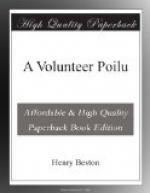“On the night of the 9th I heard a good deal of noise, and somebody woke up the Boches sous-officiers who were quartered in a house across the street. I saw lights and heard shouts. I was peeping out of my window all the time. The dark street filled with soldiers. I saw their officers lashing them to make them hurry. They harnessed the artillery horses to the guns, and at four o’clock in the morning there was not a single Boche in Pont-a-Mousson. They had all gone away in the night, taking with them the German flag on the city hall. You know, monsieur, on the night of the 9th they received news of the battle of the Marne.
“For five days more we saw neither Francais nor Boches. Finally some French dragoons came down the road from Dieulouard, and little by little other soldiers came too. But, helas, monsieur, the Boches were waiting for them in the Bois-le-Pretre.”
Such was the way that Pont-a-Mousson did not become Mussenbruck. The episode is an agreeable interlude of decency in the history of German occupations, for that atrocities were perpetrated in Nomeny, just across the river, is beyond question. I have talked with survivors. At Pont-a-Mousson everything was orderly; six miles to the east, houses were burned over the heads of the inhabitants, and women and children brutally massacred.
I best remember the little city as it was one afternoon in early December. The population of 17,000 had then shrunk to about 900, and only a little furtive life lingered in the town. My promenade began at the river-bank by the wooden footbridge crossing from the shore to the remaining arches of the graceful eighteenth-century stone bridge blown up in September, 1914. There is always something melancholy about a ruined bridge, perhaps because the structure symbolizes a patient human victory over the material world. There was something intensely tragic in the view of the wrecked quarter of Saint-Martin, seen across the deep, greenish, wintry river, and in the great curve of the broad flood sullenly hurrying to Metz. At the end of the bridge, ancient and gray, rose the two round towers of the fifteenth-century parish church, with that blind, solemn look to them the towers of Notre Dame possess, and beyond this edifice, a tile-roofed town and the great triangular hill called the Mousson. It was dangerous to cross the bridge, because German snipers occasionally fired at it, so I contented myself with looking down the river. Beyond the Bois-le-Pretre, the next ridge to rise from the river was a grassy spur bearing the village of Norroy on its back. You could see the hill, only four kilometres away, the brown walls of the village, the red roofs, and sometimes the glint of sunlight on a window; but for us the village might have been on another planet. All social and economic relations with Norroy had ceased since September, 1914, and reflecting on this fact, the invisible wall of the trenches became more than a mere military wall, became a barrier to every human relation and peaceful tie.




